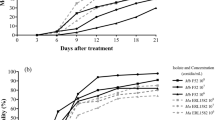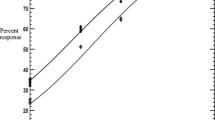Abstract
Literature on the distribution, biology, seasonal population fluctuations, economic importance, acaricidal susceptibility and measures for the control of the cattle ticks Boophilus microplus Canst., Amblyomma cajennense Fab., A. variegatum. Fab. in the Caribbean has been critically reviewed. The ticks, which inflict about $62 million annual loss on the region’s livestock industry, are still susceptible to acaricides, despite a few populations of B. microplus showing 31- to 227-fold resistance to lindane and 15- to 67-fold resistance to carbaryl, chlorfenvinphos, dimethoate and crotoxyphos.
The screwworm, Cochliomyia hominivorax Coq. is widespread, except in Puerto Rico and Curacao, from where it has been eradicated. The annual cost of surveillance against the fly and treatment of cattle for myiasis is estimated to be about $59 million. Its eradication from the entire Caribbean region by insect sterile method is advocated.
Résumé
Revue a été faite des publications relatives á la distribution á la biologie, aux fluctuations saisoniéres de population, á l’importance économique, á la sensibilité aux acaricides et aux mesures d’enraiement des tiques du betail: Boophilus microplus Canst., Amblyomma cajennense Fab., A. variegatum Fab. dans les Caraibes. Ces tiques, qui entraînent une perte annuelle d’environ 62 millions de dollars E.U. dans l’activité d’élevange de la région restent sensibles aux acaricides, bien qu’il existe néanmoins quelques colonies de B. microplus dont la résistance au lindane est multipliée de 31 á 227 fois et dont celle au carbaryl, chlorfenvinphos, dimethoate et crotoxyphos, se situe entre 15 et 67 fois.
L’hypoderme Cochliomyia hominovorax Coq. est trés répandu, sauf á Puerto Rico et á Curacoa d’oú il a été éliminé. Le cout annuel de la prophylaxie de cette mouche et le traitement de la myasie des troupeaux est estimé á prés de 59 millions de dollars E. U. Il est suggéré de procéder á son éradication de l’ensemble de la région par la methods des insectes stériles.
Similar content being viewed by others
References
Ahrens E. H., Gladney W. J., McWhorter G. G. and Deer J. A. (1977) Prevention of screwworm infestation in cattle by controlling Gulf Coast ticks with slow release insecticide devices. J. Econ. Ent. 70, 581–585.
Anon. (1975) Cattle tick in Australia. Enquiry by the Cattle Tick Control Commission. Aust. Govt. Publ. Servs. National Library of Australia, Canberra. 108 p.
Arthur D. R. (1960) Ticks. A monograph of the Ixodoidea. Part V on the genera Dermacentor Anocentor, Cosmiomma, Boophilus and Margaropus. Cambridge Univ. Press. 251 pp.
Ault C. N. (1948) Investigaciones sobre los dificultades de combatir la garrapata B. microplus. Rev. med. vet. B. Aires, 30, 174–211 and 254–297.
Baumhover A. H. (1966) Eradication of the screwworm fly. J. Am. med. Assoc. 196, 240–248.
Bram R. A. (1975) Tick-borne livestock diseases and their vectors. 1. The global problem. Wld. Anim. Rev. (FAO). 16, 1–5.
Burridge M. J., Birnie E. F., Barre N., Camus E. and Uilenberg G. (1986) Heartwater and dermatolophilosis in the Caribbean. In Press.
Bushland R. C. (1975) Screwworm research and eradication. Bull. ent. Soc. Am. 71, 23–26.
Butler J. J. and Gibbs E. P. J. (1984) Distribution of potential soft tick vectors of African Swine Fever in the Caribbean region. Prev. Vet. Med. 2, 63–70.
Coppedge J. R., Goodenough J. L., Broce A. B., Tannahill F. H., Snow J. W., Crystal M. M. and Del Var Petersen H. (1978) Evaluation of the Screwworm adult suppression system (SWASS) on the island of Curacao. J. econ. Ent. 71, 579–584.
Cruz J. de la and Cerny V. (1971) The annual dynamics of development in the larvae of B. microplus. Poeyana, Havana, 91, 1–6.
Diamant G. and Strickland R. R. (1965) Manual of live-stock ticks for animal disease eradication personnel. USDA Res. Serv. Washington, 120 pp.
Dias E. and Martin M. A. (1939) Spotted fever in Brazil. A summary. J. Trop. Med. 19, 103–108.
Dindial P. (1978) Studies on the life cycle and seasonal incidence of Boophilus microplus (Canestrini, 1888) in Trinidad and Tobago. M. Phil Thesis, Faculty of Agriculture, University of the West Indies, St. Augustine, Trinidad.
Dove W. E. (1937) Myiasis in man. J. econ. Ent. 30, 29–30.
Drummond R. O., Cadogan B. B. and Wilson T. M. (1981) Ticks on livestock in Barbados. Vet. Parasitol. 8, 253–259.
Drummond R. R. and Whetstone T. M. (1975) Oviposition of the Cayenne Tick, Amblyomma Cajennense in the laboratory. Ann. ent. soc. Am. 68, 44–46.
Edwards W. H. (1949) Tick Control. Circ. No. 30. Dept. Agric. Jamaica. 11 pp.
FAO (1971) Recommended methods for the detection and measurement of resistance of agricultural pests to pesticides. Tentative method for larvae of cattle ticks, Boophilus Spp. FAO method No. 7. FAO Plant Prot. Bull. 19, 15–18.
FAO (1984) Animal Health Yearbook. FAO Animal Production and Health Ser. No. 18. FAO-WHO-OIE. Rome. 204 pp.
Garris G. G. and George J. E. (1983) Efficacy of crotoxyphos sprays for the control of the southern cattle tick in Puerto Rico. J. Agric. Univ. of Puerto Rico. 67, 256–261.
Graham O. O. and Hourrigan J. L. (1977) Eradication programs for the arthropod parasites of livestock. J. Med. Ent. 13, 629–658.
Hall D. G. (1948) The blowflies of North America. The Thomas Say Foundation Publ. 477 pp.
Harley K. L. S. and Wilkinson P. R. (1971) A modification of pasture spelling to reduce acaricide treatment for tick control. Aust. vet. J. 47, 108–111.
Harris W. W. and Burns E. C. (1972) Predation on the lone star tick Amblyomma americanum by the imported fire ant Solenopsis saevissima. Environ. Ent. 1, 362–365.
Johnston L. A. Y. (1968) The incidence of clinical babesiosis in cattle in Queensland. Aust. vet. J. 44, 265–267.
Knipling E. F. (1960) The eradication of the screwworm fly. Sci. Am. 203, 54–61.
Lecky T. P. (1960) Fifty years of cattle breeding in Jamaica. Min. Agric. and Lands pamphlet, Jamaica. 16 p.
Lombardo R. A. (1975) Socio-economic importance of cattle ticks in the Americas. Proc. Eight Inter-American meeting at the Ministerial level on foot-and-mouth disease and zoonosis control. Guatemala, April 16–19, 1975.
Mansingh A. (1984) Diseases and ailments affecting cattle and livestock: external parasites in livestock manual for the tropics. Jamaica Livestock Assn. Kingston (Publ.) p. 163–168, 406 p.
Mansingh A. and Hammond L. H. (1978) The invasion of white cattle egrets. Jamaica J. 11, 57–59.
Mansingh A. and Rawlins S. C. (1977) Antigonadotropic action of insect hormone analogues on the cattle tick B. microplus. Natur-Wissenschaften 64 (1), 41.
Mansingh A. and Rawlins S. C. (1979) Inhibition of oviposition in the cattle tick B. microplus by certain acar-icides. Pestic. Sci. 10, 485–494.
Murray V. I. E. and Thompson K. (1976) Myiasis in man and other animals in Trinidad and Tobago (1972–1973). Trop. Agric. (Trinidad) 53, 263–266.
Newstead R. (1910) Ticks and other blood sucking arthropods of Jamaica. Bull. Dep. Agric. Jamaica 1, 145–175.
Perreau P., Morel P. C., Barre N. N. and Durand P. (1980) Existence de la cowdriose (heartwater) a Cowdie ruminantium chez les ruminants des Antilles françaises (La Guadeloupe) el les Mascareignes (La Reunion et Ile Maurice) Rev. Elev. Med. Vet. Pays Trop. 33, 21–3.
Peterson R. D., Mclnnis D. O., Whitten C. C. and Coppedge J. R. (1983) Dispersal and distribution of ground released screwworms in South Texas. (1980) USDA Animal and Plant Health Inspection Service. Veterinary Services Reports, APHIS 91–57, 1–10.
Rawlins S. C. (1978) Toxological and biological studies on Jamaican and other Caribbean populations of the cattle tick B. microplus. Ph.D. Thesis, UWI 227 p.
Rawlins S. C. (1979) Seasonal variation in the population density of larvae of Boophilus microplus. Bull. ent. Res. 69, 87–91.
Rawlins S. C. Alexander F. C., Moe V., Caesar E., Moll K. and Applewhaite L. (1983) Screwworm myiasis in the Southern Caribbean and proposals for its management. J. econ. Ent. 76, 1106–1111.
Rawlins S. S. and Barnett D. B. (1983) Internal human myiasis. W.I. Med. J. 32, 184–186.
Rawlins S. S. and Chen Sang J. (1984) Screwworm myiasis in Jamaica and proposals for its eradication. Trop. Pest Managm. 30, 125–129.
Rawlins S. S. and Mansingh A. (1977a) Susceptibility of a Jamaican strain of the cattle tick Boophilus microplus to various acaricides. PANS 23, 137–142.
Rawlins S. S. and Mansingh A. (1977b) Relative susceptibility of Jamaican strains of Boophilus microplus, Amblyomma cajennense and Anocenter nitens to various acaricides. J. econ. Ent. 70, 697–698.
Rawlins S. S. and Mansingh A. (1978a) Acaricidal sus-ceptibility of 5 strains of Boophilus microplus from 4 Caribbean countries. J. econ. Ent. 71, 142–144.
Rawlins S. S. and Mansingh A. (1978b) Patterns of re-sistance to various acaricides in some Jamaican populations of B. microplus. J. econ. Ent. 71, 956–960.
Rawlins S. S. and Mansingh A. (1979) Studies of bioassay of the toxicity of acaricidal residues on grass surfaces to larvae to the cattle tick Boophilus microplus. J. econ. Entomol. 72, 423–427.
Rawlins S. S. and Mansingh A. (1981) Susceptibility of engorged adults of the cattle tick, B. microplus to acaricides. Insect Sci. Applic. 1, 377–378.
Robinson L. E. (1926) The genus Amblyomma Cambridge Univ. Press. 302 pp.
Schnitzerling H., Schuntner C. A., Roulston W. W. and Wilson J. T. (1974) Characterization of the organo-phosphorus resistant Mt. Alford, Gracemere and Silkwood strains of cattle tick B. microplus. Aust. J. biol. Sci. 11, 397–408.
Singh N. C. (1985) Physico-chemical studies on selected pesticides. Ph.D thesis. Faculty of Natural Sciences, University of the West Indies, Kingston, Jamaica.
Smith M. W. (1974) A survey of the distribution of the ixodid ticks B. microplus and A. Cajennense in Trinidad and the possible influences of the survey results on the planned livestock development. Trop. Agric. Trin. 57, 559–567.
Smith M. W. (1975) Some aspects of ecology and lifecycle of Amblyomma cajennense (Fabricius 1787) in Trinidad and their influence on tick control measures. Annals Trop. Med. Parasitai. 69, 121–129.
Snow J. W., Hofman H. H. and Baumhover A. H. (1977) The screwworm as a pest on the island of Jamaica and the feasibility of eradication by the sterile insect method. Southwest. Ent. 2, 202–306.
Sutherst R. W., Maywald G. F., Kerr J. J. and Stegeman D. A. (1983) The effect of cattle tick (Boophilus microplus) on the growth of Bos indicus x B. taurus steers. Aust. J. Agric. Res. 34, 317–327.
Tannahill F. H., Coppedge J. J. and Snow J. W. (1980) Screwworm myiasis on Curacao. Reinvasion after 20 years. J. med. Entomol. 17, 265–267.
Tate H. D. (1941) The biology of the tropical cattle tick and other spp of ticks in Puerto Rico with notes on the effects on ticks of arsenical dips. J. Agric. Univ., Puerto Rico. 25, 1–24.
Thompson G. B. (1950) Ticks of Jamaica. B.W.I. Records and notes (including a summary of the distribution on W.I. species). Ann. Mag. Nat. Hist. Ser. 12 (3), 226–229.
Wharton R. H. (1976) Tick-borne livestock diseases and their vectors. 5. Acaricide resistance and alternative methods of tick control. Wld. Anim. Rev. 20, 8–15.
Wharton R. R. and Roulston W. J. (1970) Resistance of ticks to chemicals. Ann. Rev. Entomol. 15, 381–404.
Williams D. K., Gartman S. and Hourrigan J. L. (1977) Screwworm eradication on Puerto Rico and the Virgin Islands. World Anim. (FAO) Rev. 21–24, 31–35.
Williams H. H. and Gonzales F. O. (1968) Two tick-borne diseases of cattle introduced into Trinidad. Trop. Agric. Trin. 45, 22–32.
Author information
Authors and Affiliations
Rights and permissions
About this article
Cite this article
Rawlins, S.C., Mansingh, A. A Review of Ticks and Screwworms Affecting Livestock in the Caribbean. Int J Trop Insect Sci 8, 259–267 (1987). https://doi.org/10.1017/S1742758400007323
Received:
Revised:
Published:
Issue Date:
DOI: https://doi.org/10.1017/S1742758400007323




